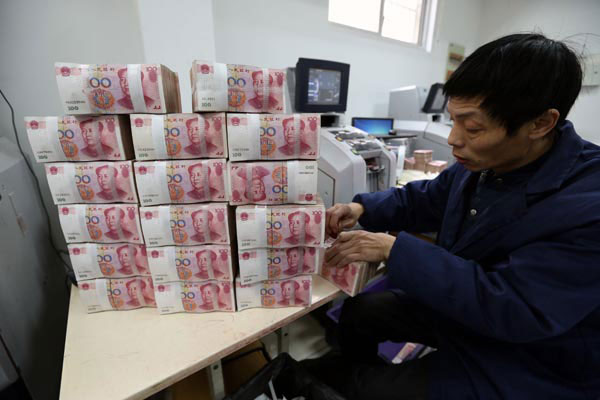
A clerk counts currency notes at an outlet of the Industrial and Commercial Bank of China Ltd in Wuxi, Jiangsu province. In December, the Chinese currency reached a record high share of 2.17 percent in global payments by value.[Photo/China Daily]
The yuan moved into the top five among world payment currencies in November, overtaking the Canadian and Australian dollars by value, the Society for Worldwide Interbank Financial Telecommunication said on Jan 28.
In December, the Chinese currency reached a record high share of 2.17 percent in global payments by value, rising from 0.63 percent in January 2013. It now trails the Japanese yen, which has a share of 2.69 percent.
“The renminbi breaking into the top five world payment currencies is a milestone. It is a great testimony to the internationalization of the renminbi and confirms its transition from an ‘emerging’ to a ‘business as usual’ payment currency,” said Wim Raymaekers, head of banking markets at SWIFT.
“The rise of various offshore renminbi clearing centers around the world, including eight new agreements signed with the People’s Bank of China in 2014, was a key driver of this growth,” Raymaekers said.
Global renminbi payments increased in value by 20.3 percent in December, compared with a 14.9 percent rise for all currencies. Over the past two years, the renminbi has shown consistent triple-digit growth with an increase in the value of payments by 321 percent, SWIFT data showed.
China’s currency continued its ascent in global payments settlement, trade and currency investment with the support of a rapidly expanding network of offshore yuan-clearing centers, which facilitate direct access to China’s onshore financial markets, said Fitch Ratings in a report earlier this month.
In 2014, eight offshore yuan-clearing centers were established in major financial centers such as London, Frankfurt and Luxembourg. An additional two were established in Kuala Lumpur and Bangkok. There are now 14 offshore yuan-clearing centers.
Fitch Ratings expects the proliferation of these offshore yuan-clearing centers to drive greater issuance of dim sum bonds (yuan-denominated debt issued offshore) by Chinese and other governments, financial institutions and corporations in 2015.
The yuan declined to a record discount against the Chinese central bank’s reference rate on Jan 28, pushing it toward the daily trading limit as the dollar strengthened.
The currency dropped 0.07 percent to close at 6.248 per dollar in Shanghai, according to prices from the China Foreign Exchange Trade System. It fell to as low as 6.2488, or 1.97 percent weaker than the People’s Bank of China reference rate and close to the daily trading band’s limit of 2 percent.
The monetary authority raised the fixing by 0.13 percent on Jan 28, the most since Dec 8, to 6.1282.
On Jan 26, the yuan touched a seven-month low of 6.2569.
Liu Hong, a researcher at Bank of China (Hong Kong) Ltd, said in an article on Jan 27 that the latest weakness of the yuan was influenced by the US Dollar Index hitting 52-week high of 95.48 on Friday.
The US Dollar Index measures the value of the dollar against a basket of foreign currencies.
It was launched at 100 in March 1973 and has traded at a high of nearly 165 (February 1985) and a low of about 71 (March 2008). The basket represents most of the currencies of the United States’ major trading partners, but not China. The basket is about 57 percent in the euro, 13 percent in the yen and 9 percent in the Canadian dollar.
